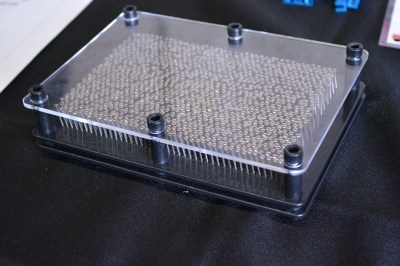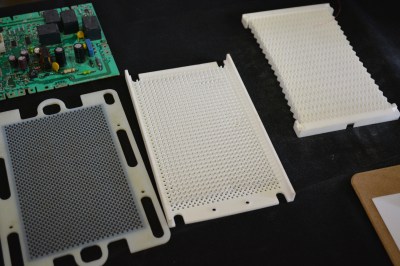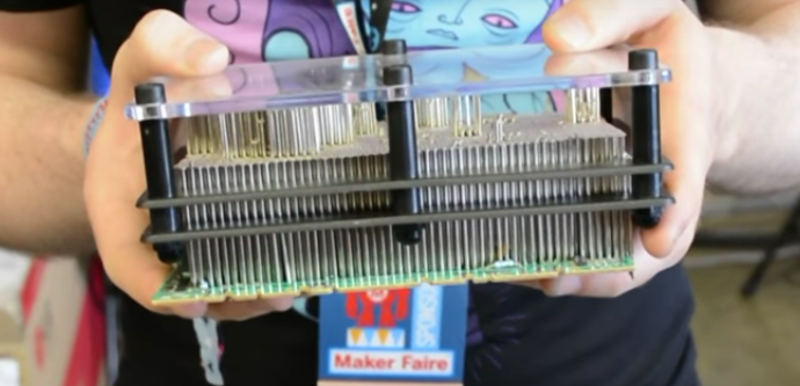There’s an old adage that when performing a live demo, previously working hacks will mysteriously go awry. In this case, the hardware demo was doomed before it ever arrived at the conference.
PinJig is an interesting take on though-hole soldering. As its name indicates, it’s a jig which holds through-hole components in place as the board is flipped on its side (or even upside down). This is accomplished by 2000 steel pins which are locked in place after being nestled around all of the board’s components. Unfortunately, carrying this prototype onto an international flight didn’t work out. [Niall Barrett] told us that on his way from Ireland to Bay Area Maker Faire he was required to ditch the 3-inch steel pins that make up the jig, or not get on the plane.
I still really enjoyed speaking with him at his booth where he was showing off the various mechanisms that led to this prototype. Holding through-hole components in place while soldering is a pain — literally. I’ve mildly burned my fingertips numerous times holding components (like pin headers) in place with one finger while trying to apply iron and solder with the remaining digits and other hand. I’ve used blue tack, various types of tape, a third-hand tool, stacked the board and component on random stuff from the bench, and a lot of other half-solutions. It’s not really a problem that has a commercial solution since in production, wave soldering brings molten solder to the underside of the board and gravity does the clamping.
 The inspiration for this device comes from Pin Art — a toy which has hundreds of pins arranged in a tightly packed grid. Raise your hand up form the underside and the heads of the pins form a contoured map of it, or any other object. PinJig works much the same way. Place it over the through-hole components and you’ll get a map of the the shapes in the pins. Then lock the pins in place and you can flip the entire assembly over to get at the underside of the board for soldering.
The inspiration for this device comes from Pin Art — a toy which has hundreds of pins arranged in a tightly packed grid. Raise your hand up form the underside and the heads of the pins form a contoured map of it, or any other object. PinJig works much the same way. Place it over the through-hole components and you’ll get a map of the the shapes in the pins. Then lock the pins in place and you can flip the entire assembly over to get at the underside of the board for soldering.
The trick is that locking mechanism. In the video above [Niall] shows off several different prototypes for that lock. First was a plate with a grid of teardrop shaped holes where the pointy part of the tear was rubberized. The second attempt had a plastic tooth parallel to each pin (like a hair brush) that would contact the pins when the plate slides to one side. The third attempt was a set of plastic fins that zig-zag between pins and contact them when stretched.

None of these early attempts were reliable, but the third iteration helped [Niall] realize what would work, stringing fishing line between all the pins. When the line is put under tension this serves as an adequate lock.
Unfortunately we could get a look at a prototype for this because of the missing pins. It also seems like the Indiegogo campaign was not a success as I get a message that the campaign “is currently being updated”. Still, the mechanism is an interesting one, and I could see this being popular to have on hand at hackerspaces or other community workshops where many people are likely to be working on through-hole projects.
















wow maybe I’m the only guy that bends a little bit the legs of the resistors, capacitors etc. to prevent them from falling? Things like relays are a bit different, but you can always hold them with a finger, solder one point for each relay and then solder the rest of the pins without having to put a finger. I think this thing is just a waste of money.
I save the foam bricks used for packaging and use those.
Place a foam block over the board, press down, and flip the entire system upside down.
It’s the poor-man’s version of the foam press noted below. I didn’t know there were solutions available.
The pin thing seems pretty cool to me, mostly due to nostalgia from when these things were popular desk toys.
However, I just use blobs of poster putty to hold components in place temporarily.
Yeah i have to say thru hole soldering is probably the last thing i worry about as far as soldering goes
No, you’re not the only one. Most soldering guides even tell you to bend the leads a little to hold the component into place. This is a solution in search of a problem, IMHO.
But congrats on teaching yourself electronics!
yep. bend your pins, It’s been the standard for well over 60 years. and yes even relays I bend the pins a little. I have yet to find a Through hole component you cant do that to.
Goldpin headers. They’re thick and have short legs.
The industry is way ahead already. There are even special pliers out there to bend a consistent notch into the legs of thru hole components.
In the lab we have some nice soldering frames where you can clamp in your pcb, insert all the components, then you can close a lid with a foam insert over the components. once closed, you just flip the frame over and start soldering away.
Since we got rid of most TH components in our products we don’t really use these frames anymore tho. Usually, to solder some pin header or other TH components, i use some self clamping tweezers or just a piece of sticky tape to hold the few thru hole parts in place for manual soldering.
Are these the pliers you speak of? I wish these werent so damn expensive! I would buy these in an instant
https://www.amazon.com/50788-U-Shaped-Forming-Passive-Components/dp/B004UN8LTU/ref=sr_1_2?rps=1&ie=UTF8&qid=1467128406&sr=8-2&keywords=resistor+lead+forming+tool&refinements=p_85%3A2470955011
Prestik!
The sticky rubber like substance you put your posters on your wall with? I am sure you have it in your country. Just keep it away from the hot surface.
Yep. And with some double sided tape, you can dispense with a soldering vice.
And with a candle and a nail, you don’t need a soldering iron.
Except the goal really isn’t to get by with the minimum of tools.
This is not a need, it’s a nice to have. An aid to working faster or more comfortably. And work holding tools help.
I don’t “need” a soldering vice, but it makes it a hell of a lot more enjoyable to solder a through hole board with it held firmly at my preferred angle and height. With a nice bright light above, and a head mounted magnifier.
Can I solder without all this? Sure. And I can prepare a meal with a Swiss army knife.
But julienne carrots are far easier with a nice sharp kitchen knife than a little Swiss army knife blade.
Yes, that’s what I’ve been doing. Since the ’70s.
I’m confused, the device is for through-hole right? It said surface mount in the article, but that isn’t making sense to me.
Thanks for mentioning it, that is just a gaff. I’ve changed that to “through-hole”.
Of course it has a commercial solution.
Mounting frames are a metal frame with groves to hold the PCB and a padded lid to press down the components.
You clamp in the PCBs, stick all your components in, close the lid, flip the whole thing and start soldering.
https://s32.postimg.org/uc7org58l/ideal_tek_pcsa_1.jpg
And there are even smaller ones with a moveable sponge-thing for hobbyists:
https://s31.postimg.org/tcav16nl7/LOTHILFE.png
Very cool, thanks for pointing this out!
Yeah. I’ve got a small one and it is really handy also for holding the PCB in general while poking around with a multimeter or so.
Yeah thanks! I could make one of these.
These two are nice!
Any links or stuff to google for buying these or similar?
The name “mounting frame” seems to be a bit too generic. The German “Bestückungsrahmen” is more specific. You might want to search for the Weller ESF-120 – That’s the small one I’ve posted.
Thanks for sharing! I have used foam behind the board to supplement bending pins, but those look way nicer than trying to balance my board on the kitchen sponge! I wonder if cutting straps of foam to fit in a stickvise would work?
You just need a heat-resistant sponge. Ordinary foam or sponges might melt. These sponges for soldering iron tip cleaning might work when you make them a bit wet.
Water-filled party balloons under low pressure – they won’t burst because water has good thermal capacity, and will adjust their shape to solids they contact with.
Annie is such a strange name for a man. Where you parents Johnny Cash fans?
https://www.youtube.com/watch?v=_rleFAS_B04
I’m glad I wasn’t the only one scratching my head at that.
http://www.thingiverse.com/thing:965574
Found this on some time ago while I was looking for something else. It’s on my to-print list.
I saw this at another Maker Faire & believe the primary differentiator may be the range of component heights that can be soldered in a single step and possibly cost(?).
I am not sure(?) if the foam based approach can handle taller components and adjacent low-profile resistors at the same time, for example.
AFAIK, the crowdfunding campaign was deferred.
What about using pick-and-place foam, from storage boxes? It’s cut into squares already, so could handle a tall component next to a short one.
Did you mean pick&pluck foam?
If so, the grid size might be a limiting factor as well a temperature during soldering.
I presume the foam used in the jigs above can handle high temperatures.
However an interesting idea :)
Of course you would have to create a foam template for every PCB rev.
Based on how the pick-and-place foams I’ve had experience with have all outgassed at room temperature over time, I’d hesitate to put any serious degree of heat to them, even with good ventilation. Yuck.
nice one! And it should not be too difficult to replicate with stuff from my “you never know when this might come in handy” pile.
SpongeArm SquareClamp.
Bit ironic that I remember first seeing a mini pin art on a UAL transpacific flight in the 80s. It was one of those 80s chrome, glass, & black executive desk gadgets; like those force transfer horizontal stack clicking pendulum balls.
What did the TSA think, that he was going to nail together some small bits of wood he gathered on the plane and make a club?
What did the TSA think
I think you’re giving them too much credit…
You got the punctuation wrong, here let me correct it for you…
“What, did the TSA think?”
Are you kidding? No you, got it, wrong; you t”o”tal nob. You have written the most offensively annoying and pointless comment I have ever seen. And that really is saying something. Enjoy. This,
Aww forget it I’m drunk
Well, some of us think that was funny.
Not TSA, this happened in Ireland. And while they are required to screen people for things the US has explicitly banned from US bound flights, foreign airport security does their own thing. I’ve had lead bean bag weights confiscated coming back from a dive trip. Try and figure out the danger of a lead bean bag vs. the 1lb brass regulator on the end of a 3ft hose that was also in my carry on).
My guess is that they’re confiscating anything that could be shot or shrapnel, on the point that the person /might/ manage to build a bomb or some kind of gun or projectile throwing weapon on the airplane and load it up with the lead weights or nails, etc.
Makes sense, because pocket change, pens, souvenir glasses and metal forks would be totally harmless are shrapnel.
#ThanksTSA!
A nailbomb. Obviously.
Combine with a drinking straw and some bits of napkins, you could make a blow dart gun!
heh, i’ve always just used hot melt glue to hold parts in place while soldering.
2000 steel pins (which are basically nails)…
Seems a little bit excessive even by diy ( or MacGyver…) standards.
Take a look at the pin retaining plates in the last picture. That’s some pretty detailed 3D printing.
If you are burning your fingers soldering thru-hole components, you haven’t soldered enough thur-hole components
Cute idea but total engineering over kill.
Get a sheet of soft “cheese wax”,
place in in zip lock bag,
microwave it just enough to soften it,
place over populated board,
place cold pack over wax bag and wait a short while for it to harden then,
invert and solder.
Just don’t over heat your board or the wax will start moving, then again that is probably a good warning sign that you are over heating components so more of a feature than a bug.
And this is why lots of little pins worry security people, wait until the end to see what remains of “Ivan”.
https://www.youtube.com/watch?v=xHs86nH2x4I
Even easier: use foam: allows different heights of components and can apply enough pressure for this application.
Perhaps memory foam would be the best? Needs some experimenting.
But the main ingredient of the claymore was missing.
Because “the other guy” had it…. duh. You’d make a lousy bad guy.
“TERROR!!!11!!1! TERROR EVERYWHERE!!!!1!!!1!”
Where is my vomit-bucket. -.-
I feel the same.
Do they still make people take off their shoes? ;)
Your socks are a chemical weapon.
I must’ve used too much bleach the last time I washed my socks.
Its an international flight, what was he doing carrying such a device through security anyway?
Put it in checked baggage, I am sure they would have given the guy a chance to go back out and check it in if he had asked…
On the hack note, I think the sponges i saw above look like a better idea
They’re not going to bring his luggage back so that he can put something into it. And that’s if he even had any checked luggage, if he was only going to be there for one night he could have had everything in carry on.
Very often you can put such “offending” objects in extra checked luggage. Probably depends on the airline. Of course it is less convenient, if you planned saving the time by having only carry-on.
I built a board vise years ago in the vein of the frame style with a lid that is supposed to clamp down, but I only ever got a board vise out of it. I was looking for foam that wouldn’t melt and silicone foam wasn’t as easy to find as it is now. But honestly, I just bend my pins and everything works fine without resorting to crazy jigs. I’ve abandoned the frame jig for a panavise with a board holder clamp since then. This, while a novel idea, isn’t that great. It’s bulky and heavy and dropping it would probably destroy it. I’d also use aluminum pins as solder won’t stick, but again, dropping it one time and it’s done. Great concept, but….
I want More TSA! I love it when they make me feel like a farm animal. MORE!
one lesson is to postal mail things (instead of carrying on planes) that matter for demos and trade shows.
and if its really important, do both.
Yes, TSA stuff sucks, but the person is just doing their job, if they don’t recognize it or understand it, and it looks dangerous, and the person gets an attitude or overzealous about it being safe, yea, then it’s not going on board. I’ve had stuff questioned, I simply say I u detest and and simply ask, can I check my bag? 90% of the time, yes, and even a couple times, they consult with another member and let me bring on board. It’s in your attitude, but for the most part, just be aware that yes, you know what it is, but 90% of the people around you do not. Even my ink refil (I mix inks) for my fountain pens looks menacing to some.
Don’t forget he was flying from Ireland, once the terrorism capital of the world…
With something closely resembling a claymore…
A bunch of nails and some ABS or PLA does not make a claymore.
Most people don’t even know what a claymore is. They just know that it’s dangerous.
Well… a claymore doesn’t generally have nails in it. Ball shot or BBs usually… or a long piece of weapons grade steel attached to a strong handle.